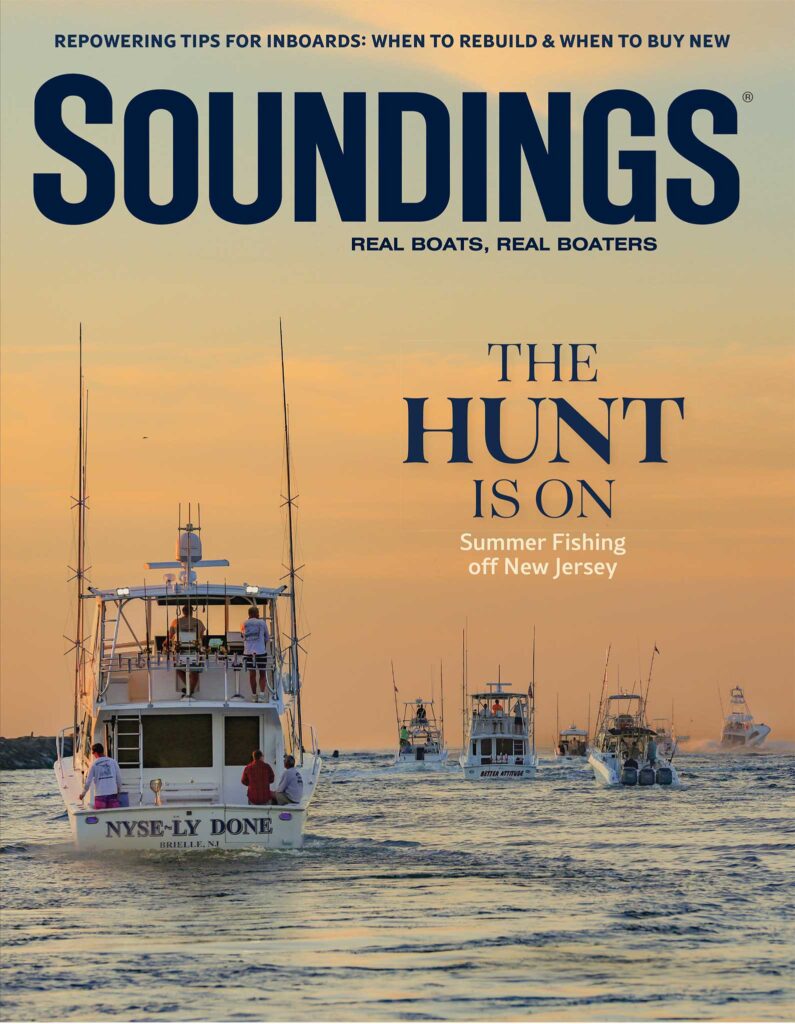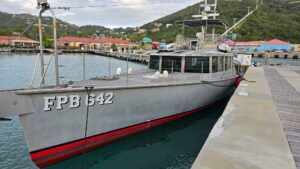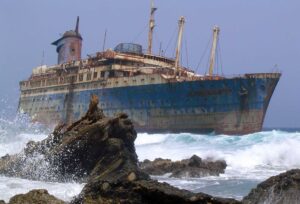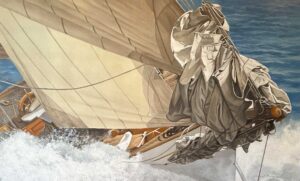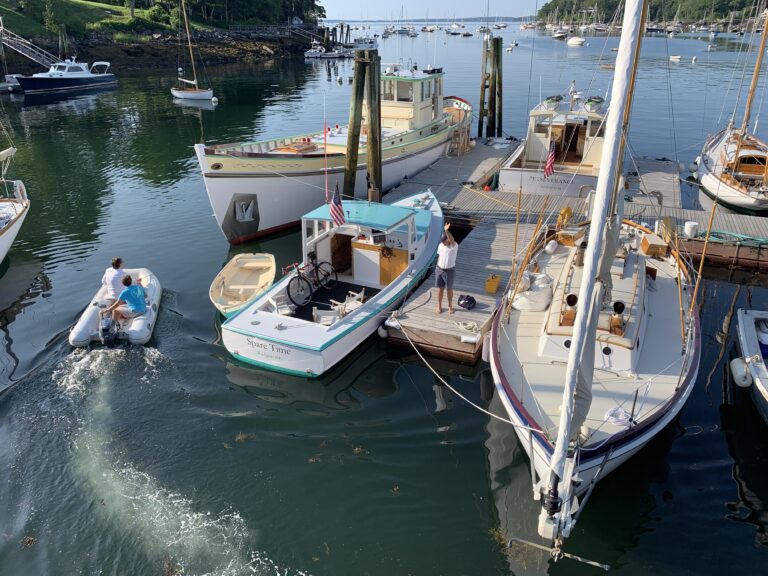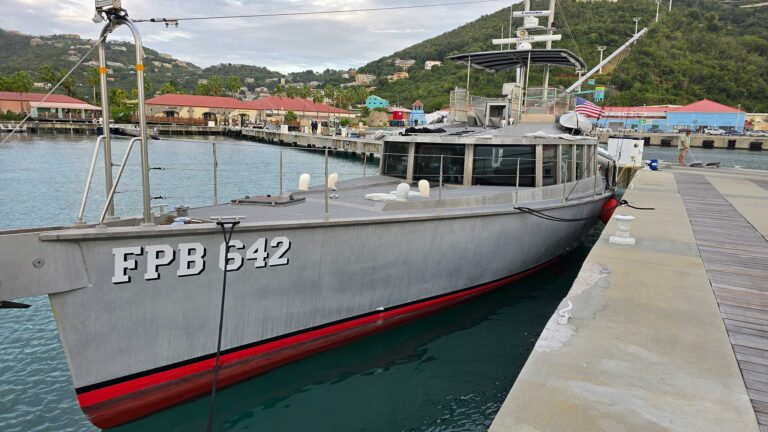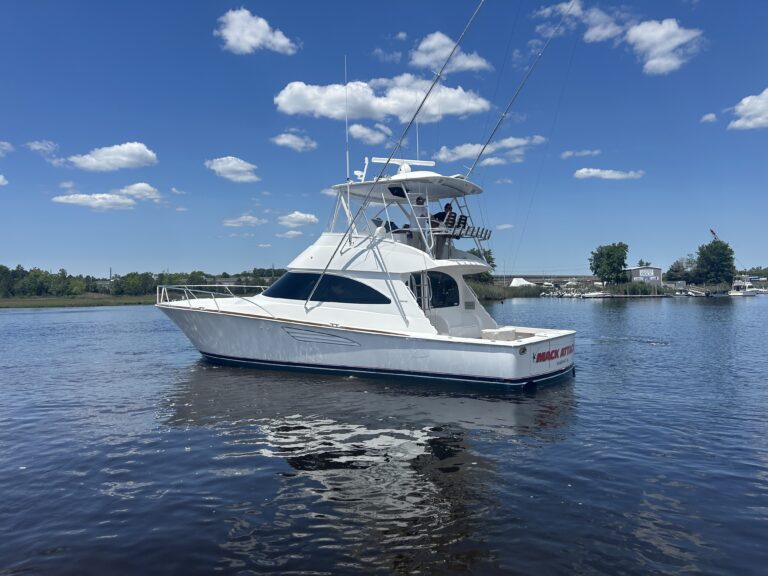It’s an odd thing, winning a seamanship award for abandoning your boat. So much so that when the Cruising Club of America told Carter Bacon that he was being awarded its Rod Stephens Seamanship Trophy, he asked them why.
They told him the recognition was in honor of his timing. A lot of sailors, they said, would have failed to decide early enough to leave their boat, to allow for an orderly rescue.
Bacon is philosophical about the loss of the boat he owned for 24 years. “It’s not as heartbreaking as somebody being hurt or killed,” Bacon says. “It’s not even in the same category.”
That, of course, is precisely the point. The Cruising Club’s award announcement cites Bacon’s “meritorious handling” of the sinking of his 50-foot K. Aage Nielsen sloop Solution. It happened during the return sail after the 2024 Newport Bermuda Race, when he and his crew were 200 miles south of Cape Cod, Massachusetts. The U.S. Coast Guard whisked them to safety. Two days later, electronics readouts showed the boat going down, having finally filled with enough water to sink her about 35 miles south of where they were rescued.

For Bacon, who is 74, the incident was an unfortunate way to cap off seven wonderful decades of sailing. He grew up spending summers on Cape Cod, learning in a Beetle Cat before moving up to a Wianno Senior Class, which he raced for 40 years. There was also his father’s John Alden schooner on Lake Michigan, a 55-foot classic built in 1924.
“It became a big part of my life after I graduated from college,” Bacon says. “He let me spend a winter working on that boat, and I took it on a long, two-and-a-half-year trip down the St. Lawrence River to Nova Scotia, then down the East Coast to the Caribbean and through the Panama Canal into the Pacific. I was on the west coast of South America and in the Galapagos for a while. It was amazing.”
The demands of a law career, a wife and five children then took precedence over his long-distance sailing ambitions, but he always raced in the
Wianno Senior Class, as well as on friends’ boats. Solution came into his life in 2000, after years of talking with his wife about buying a cruising boat. It was a 1963 build that he’d first seen as a child, during his first sail to Martha’s Vineyard.
“I was allowed to go over there with two other kids and race in the Edgartown regatta,” he recalls. “She was a new boat and quite celebrated that summer. Her owner was a well-known racing guy. I can still remember being struck by how beautiful it was. I never forgot it.”
All those years later, as soon as he bought her, Bacon started racing Solution. He completed five Newport Bermuda races and did the 2015 Transatlantic Race. After he completed his sixth Newport race in 2024, he turned the bow back north to the boat’s homeport in Rockport, Maine. He had his 37-year-old daughter, Elizabeth Bacon, on board, as well as a couple who were new to them as crew.
The sloppy weather they encountered in the Gulf Stream didn’t even give him pause. He’d sailed aboard Solution in much worse. “It wasn’t particularly stormy,” he says. “It was gusting to 30. But we were in the Gulf Stream current headed north, and the wind was coming right out of the north, so you had wind and current opposing each other. The waves stack up. As you go up a wave, instead of coming down the back side of it, you literally fly out of it. The boat pounds.”
Solution was built to take that kind of a pounding, he says, but she was also 61 years old, and something let go. “After two or three severe waves, we just came out of the wave and bang, it felt like the boat had been dropped in a parking lot,” he says. “[She] probably cracked one or more frames, which would allow the planks to move. It would take an infinitesimal amount of movement to open up two planks to water, and the boat is double-planked, so all I could see was water coming in everywhere.”
He was at the helm in the cockpit when it happened, and at first, he didn’t even realize they were taking on water. When they got out of the pounding, his daughter took the wheel and he went below, about 45 minutes after they came out of the Gulf Stream. “The bilges were filled enough that I could hear the sloshing,” he says.
He checked all 11 of the thru-hull fittings, but he couldn’t find the leak, and most of the fittings were underwater by that time anyway. He checked the spot where the prop shaft goes through the hull, along with all the other usual suspects. He found nothing.

“At that point, you’re kind of out of places to look unless the hull is split in half,” he says. “It was just seeping in everywhere. I have bilge pumps of course, and I flipped on the main pump immediately. It could pump out the volume of water I was seeing in a couple of minutes, but nothing happened. A second emergency pump flipped on automatically. The next time I looked 10 minutes later, the water had risen.”
That’s when he decided to call for help. On his satphone, he hailed his brother in Maine, who contacted the Coast Guard. Bacon also used his VHF radio to contact a boat he could see on AIS about 10 miles away. Its crew was in the middle of a sail change and didn’t immediately get the message, but eventually turned to help.
“By the time that happened, the Coast Guard officer on Cape Cod called me on my satellite phone and said, ‘We have two aircraft in the air already,’” Bacon says. “It was sinking at an alarming rate—alarming enough that I had no plan to stop the sinking—but I had time to deal with the rescue.”
The experience, he said, was entirely different from other problems he’s had on board because he couldn’t figure out the source or extent of the damage. A true emergency, he learned, produces a different feeling than trying to solve a defined problem at sea.
“I knew I couldn’t sail it or push it because I could easily make that hull damage much worse if I put any strain on it at all,” he says. “The only thing you can do is decide to do whatever is necessary, because you can’t take any risks with people’s lives.”
Another lesson learned, he says, is to call for help the minute you realize you’re not dealing with a normal problem—and then understand that you are done. Make your peace with the reality of the situation, and get everyone off the boat safely.
And don’t take such an old wooden boat offshore, no matter how well it’s maintained. “I hate to say that to people,” Bacon says. “There are a number of boats that fit that description—boats I know very well, whose owners I know well—and they take really good care of those boats. Solution, since I’ve owned her, has been taken apart and put back together three times, just looking for trouble and fixing the smallest things. But I don’t think there’s any substitute for a new boat.”
As for whether he’ll be purchasing one of those new boats, Bacon says the answer is no. It’s not because of what happened, but simply because of his age. Chartering, if anything, is his more likely future.
“I’ve come to terms with it all,” he says. “I’ll miss the boat, but I had a fabulous 24 years with it. It was pure joy for me. But I have grandchildren, and I’ve been neglecting them, so I’m going to spend more time with them.”
April 2025

